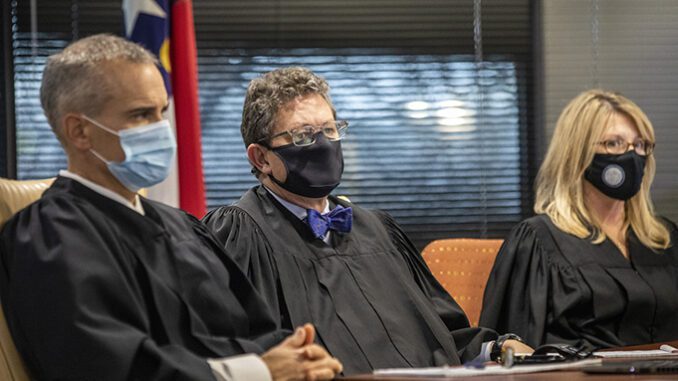
RALEIGH — North Carolina’s maps for congressional and state legislative seats are getting their brief time in court after the state Supreme Court ordered the Wake County Superior Court to render an initial decision on the fairness of the maps by Jan. 11. Arguments began Jan. 3 and will conclude Jan. 6. This decision will then almost certainly end up back in the state Supreme Court after the losing party appeals.
After 2020 U.S. Census results showed N.C. had gained enough population relative to other states to earn an extra congressional seat, the stakes were raised further in the once-a-decade map-drawing process — one constitutionally assigned to the state’s General Assembly and with no veto threat from the governor. With GOP majorities in both the state House and Senate, Republicans were able to direct the process and passed new maps into law. According to the liberal groups who have since sued over the maps, though, Republicans drew the maps in a way that would tilt the partisan balance too much to their advantage.
Initially, there were two separate court cases against the new maps by left-leaning groups, but the court decided to combine the cases. Voter groups Common Cause and the North Carolina League of Conservation Voters (NCLCV) claim in the suit that the maps are unfair in that they create 10 solid Republican seats out of 14 total seats in a state where neither party dominates statewide races.
Some initial fireworks in the case surrounded the “optimized maps” that the NCLCV proposed to replace the General Assembly’s maps. NCLCV initially would not reveal how its maps were created and wanted the person in charge of the process to be shielded from any questioning from the defense’s legal team. But the court rejected this motion, opening the mapmaker, NCLCV’s lead attorney in the case, Sam Hirsch, up to questions on how the maps were made.
Republicans blasted the NCLCV and Hirsh for this, with co-chair of the Senate Redistricting Committee state Sen. Warren Daniel (R-Burke) saying in a press statement, “The brazen hypocrisy is remarkable. We drew districts in open committee in full view of the public. Now a political action group hired a litigator to draw maps in secret, wants those maps ordered into law, and insists the mapmaker should be immune from any public scrutiny of proposed districts that produce results another Democratic expert panned as a massive gerrymander.”
Republicans also blasted the NCLCV’s optimized maps as being outliers to a far greater degree than the General Assembly’s ones they were suing over. The Daniel press release cited analysis by the Civitas Center for Public Integrity, a subsidiary of conservative think tank the John Locke Foundation, which predicted the NCLCV’s congressional map would produce only six GOP-leaning districts.
Republicans argue that according to the plaintiff’s expert witness, Jowei Chen of the University of Michigan, 10 GOP seats is a much more likely outcome of a neutral process than six GOP seats would be.
Chen testified that he “programmed the computer algorithm to create 1,000 independent simulated plans adhering to the following the seven districting criteria, as specified in the Adopted Criteria,” which were: population equality, contiguity, minimizing county splits, minimizing voting district splits, geographic compactness, avoiding incumbent pairings and not splitting municipal boundaries.
Out of the 1,000 congressional maps the computer created with these guidelines, all of them produced results of seven to 10 GOP seats out of 14. Maps like the NCLCV “optimized map” that had only six of 14 seats going to Republicans were created zero out of 1,000 times. Maps with seven GOP seats were created 4.1% of the time, those with eight GOP seats 30.4% of the time, those with nine GOP seats 62.1% of the time, and those with 10 GOP seats 3.4% of the time.
A map like the General Assembly’s, which had 10 GOP-leaning seats, therefore, was an outlier but a statistical possibility; whereas, the NCLCV one, according to Daniel, was “almost a statistical impossibility.”
The reason a random process (after using the agreed-upon criteria) would give Republicans at least eight out of 14 seats in 96% of maps and at least nine seats in 66% of maps — despite frequently narrow margins in statewide races — is due to how populations are spread in the state. Republicans are much more evenly spread throughout the state, while Democrats are heavily concentrated in cities and college towns.
While GOP maps with nine seats are likely (62%), and those with 10 seats are possible (3%), Chen argued this particular GOP map was an outlier in some ways when compared to the 1,000 computer-simulated maps.
“I found that the Enacted Plan does not violate the equal population requirement, nor do any of its districts violate contiguity,” Chen said in his testimony. “However, by comparing the Enacted Plan to the 1,000 computer-simulated plans, I found that the Enacted Plan fails to minimize county splits, fails to minimize VTD splits, and is significantly less geographically compact than is reasonably possible.”
Another major plaintiff witness, Chris Cooper, a professor at Western Carolina University, also took issue with the General Assembly’s congressional maps. He said the maps would result in more Republicans and fewer Democrats being elected and in fewer competitive races, adding, “This is not a result of natural packing or geographic clustering, but rather because the congressional district lines shifted in ways that, taken together, benefit the Republican Party.”
The General Assembly’s state House and state Senate maps are also being challenged in the suit. Republican legislators sent out a press release on Jan. 4 citing data from Duke University’s Dr. Jonathan Mattingly, who made 10,000 computer-simulated maps from the criteria, which put the state Senate maps right in the predicted range of results. The release from state Sen. Amy Galey (R-Alamance) said that up to 43% of the simulated maps create more likely Republican seats than their maps did.
The state Supreme Court delayed primary elections, which are typically held in March, to May 17 to allow the trial to continue. Candidates had already begun filing for the election, however, leading many to complain that the delay threw the process into chaos. But the Supreme Court placed the trial on an expedited timeline, mandating a decision by Jan. 11, to avoid further complications.
They ordered three judges on the Wake County Superior Court — Graham Shirley, Nathaniel Poovey and Dawn Layton — to determine if the maps were constitutional. Two of these judges are Republican and the third Democrat, while the Supreme Court has a 4-3 Democratic majority.



